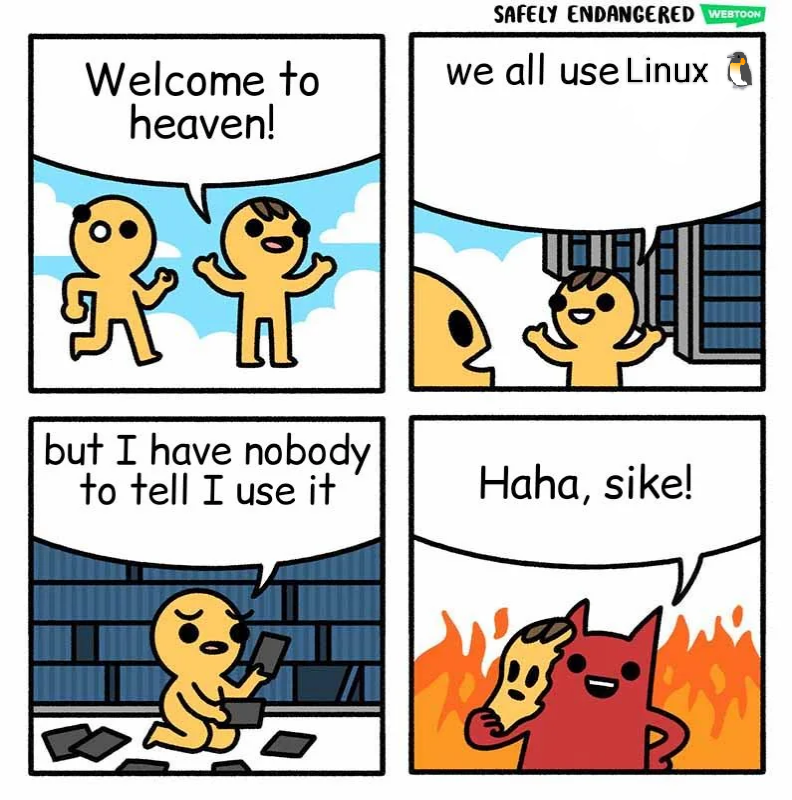Ian, is that you? I know things are still in flux, but it’s good to finally hear from you!
- 19 Posts
- 82 Comments

 16·1 month ago
16·1 month agoI learned to follow hashtags, not people on mastodon myself…

 201·2 months ago
201·2 months agowayDroid does let you do that, in a fairly lightweight way (uses Linux namespaces iirc, similar to lxc.
It’s still not full native, which would be even nicer. I play droidfish on my Linux machines using it.

I wonder if this is heaven or hell 😅

 23·4 months ago
23·4 months agoIt is finally upon us.
THE YEAR OF THE LINUX DESKTOP!
Terms and conditions apply. It could be the next year, or the year after, or not at all.

 17·4 months ago
17·4 months agoSounds like dogs barking at/with each other in the night back when I was growing up. You’d hear the occasional how-how-hoooooww from one of them, and others would join in. Wolf’ish in some ways. The city I grew up in was much less crowded back then.
Now: I guess self driving cars fill in the void left by dogs not barking at each other anymore.
🐺 — > 🚗

 7·5 months ago
7·5 months agosupertuxkart SuperTuxKart (A 3D arcade racer with a variety of characters, tracks, and modes to play.

 61·7 months ago
61·7 months agoNominative determinism is pretty accurate. Steve Jobs did generate a lot of jobs. Bill Gates had a lot of gates to his name.
</joke> just in case it wasn’t obvious

 311·7 months ago
311·7 months agoBalls of plastic. Descended from balls of steel 💪

 21·8 months ago
21·8 months agoLinux Mint Debian Edition would be a pretty solid, pre-customized distribution.
I’ve had great experiences with Linux on Lenovo over the years: would be my first recommendation.
I currently use a Dell Inspiron, while it’s works great, I had to do some extra work occasionally. I love that I can get fingerprint login with it on Linux though.
I second endless os. Parental controls, locked down system, comes prepackaged with many educational apps.
Sorry, good catch.
It had been a while since I had played briefly with kiosk mode in a VM: I misremembered the project (the one I played with was still available)
I had found it interesting, and had set it up… Probably been around a year or so.
The project I used was Gnome kiosk, not Fedora kiosk.
They do. They did. What do you do when a ‘good guy’ is really a bad guy? Happens outside of software too. Someone inserts themselves into an organization while secretly working against its interests.
Here’s a good summary. However, you should read a few articles - plenty have been going around, including on Lemmy.

As with all definitions, there is a gray area where people will have different boundaries on exact meanings. To you - a supplier relationship needs an explicit payment, which is a fair definition.
However, the more widely used definition that most people, including me, refer to, is not necessarily focused on the supplier, but on the supply - what we use in our toolchains is a supply - regardless of how it was obtained.
When there is an issue in a trusted supply, even if it was not a commercial relationship (a prerequisite by your definition), it is a supply-chain attack by the more widely used definition.
The article states reasons which aren’t limited to what happened. I understand and agree with your sentiment about the supply chain issue being something that could happen anywhere - those were my initial thoughts too.
The reasons for shifting are related to speed, other mainstream software already having made that switch years ago (pre incident), and unfortunately… More robustness in terms of maintainers.
Open source funding and resilience should be mainstream discussions. Open source verification and security reliability should be mainstream discussions: here’s a recent mastodon thread I found interesting:
https://ruby.social/@getajobmike/112202543680959859
However, people switching from x to z (I did see what you did there) is something that is going to happen considering the other factors listed in the article that I summarized above.
Linux mint Debian edition or Opensuse tumbleweed.
Slow Internet/less updates, older, more tested software, slightly wider package availability: LMDE.
Faster Internet, more updates, very new (but well tested) software, needs slightly more technical knowledge sometimes: Opensuse tumbleweed.
I personally use Opensuse Slowroll, which is a slower rolling release experimental version of Opensuse tumbleweed.
If it’s just Internet access, would you want to use something more locked down like Fedora kiosk?

 1·9 months ago
1·9 months agoBased on other posts by the author (they have posted AI generated art before, and attribute when it’s not AI generated), I’m pretty sure this is AI generated.
The fine print in the mastodon toot:
Fine print: Happy first of the fourth!
Says Happy first of the fourth, implying first of the fourth (month - April), which is what I based my own hint that this was an April fools joke in a veiled way.







The monk was able to get in with the key monk-key). He was no longer locked out!
🔒 👉 🔐 👉 🔓